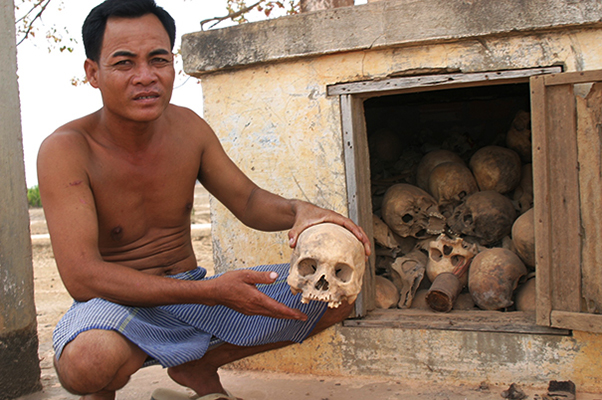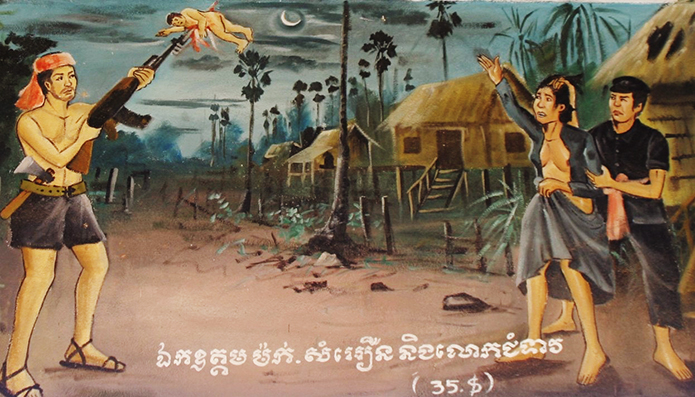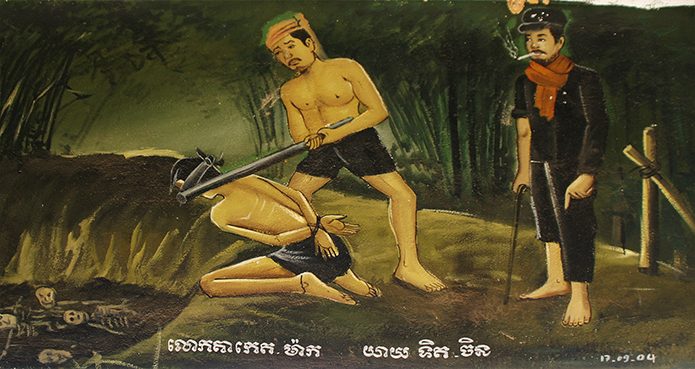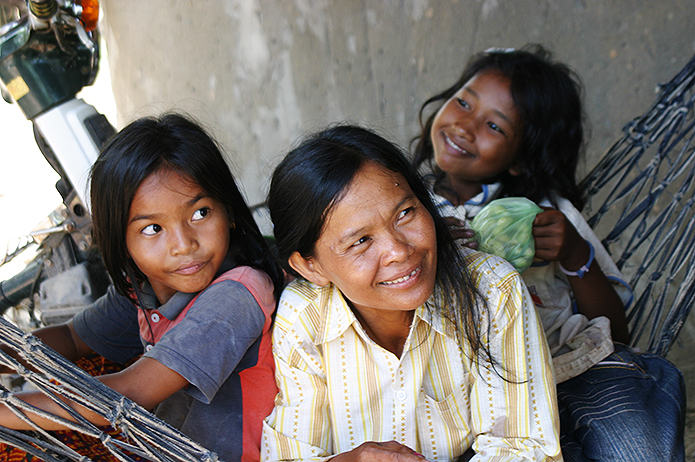Side By Side Now In Cambodia: Skulls, Victims And Killers
TRAPAENG SVA, Cambodia, May 27, 1996 : When the air grows still and heavy here in this pretty village far from any paved road, people say they sometimes hear the sun-bleached skulls of Cambodia’s holocaust, piled nearby in the ruins of a schoolhouse, talking to one another.
"Sometimes we hear them crying,” said Sim Than, a farmer. “You can hear the voices of women and children and men, just as if they were alive.”
People say they still hear the faint ring of a lunch bell, as they did more than 17 years ago when the schoolhouse served as a prison and sometimes as a torture chamber. The worst, they say, is when they hear again the moans that came to them from a thick stand of bamboo where prisoners were clubbed to death in the back of the neck.
When the people here walk their cows past the schoolhouse to graze, or when their children wander through picking small yellow berries, they sometimes stoop to replace the skulls that the cows have knocked from among the many hundreds that are piled here.
Across Cambodia, at hundreds of former killing fields like this one, scattered bones and bits of clothing lie unburied and largely ignored. And in thousands of villages like this one, men and women who worked for the Khmer Rouge have returned to their formerly quiet lives, farming their fields and raising their children side by side with the families of people they abused and killed.

Those anonymous bones and unpunished victimizers are part of the fabric of Cambodia today, less than a generation after the horrific four-year rule of the Khmer Rouge, who from 1975 to early 1979 caused the deaths of two million people in one of history’s cruelest episodes of mass murder.
Every year at the former schoolhouse 20 miles south of Phnom Penh, a small group of mourners gathers on the Day of the Dead with sticks of incense to pray for the restless souls of the victims. Among them is Chhuon Chhon, an illiterate farmer who was a teen-age guard at the prison.
“I come to cleanse my sins,” he said in an interview at his small thatched house here as his wife nursed the youngest of their four children.
“I know them very well,” he said of the skulls. “I saw them being tortured.”
Mr. Chhuon Chhon is one of five prison workers who have remained here in their home village, tied to the land of their ancestors, like other Cambodians, by tradition and the hardships of a poor farming society.
Their neighbors in this settlement of about 60 families have not sought retribution against these men, but they view them with wariness.
“I used to ask them, ‘Did you ever kill anybody there?’ ” said Nou Heam, a farmer who grows watermelons, cucumbers and red chili peppers, but he added that he had long since stopped asking. “The answer was always, ‘No, no. The killers were from somewhere else.’ They say they were just guards, but we all think that they were killers.”
Like Mr. Nou Heam, much of Cambodia seems to have sunk into apathy about the traumas of the past. To demonstrate the horrors of Khmer Rouge rule, many bones were exhumed by a new Cambodian Government in the months after what is known here as liberation, when a Vietnamese invasion drove the Khmer Rouge from power in January 1979. But since then, little has been done to lay the bones, or the memories, to rest.
Cambodia is a nation still struggling toward normalcy, burdened by a continuing insurgency, political instability and widespread poverty. Former members of the Khmer Rouge hold high positions in a new democratically elected Government, together with people who opposed them.
Some people here say that to forget and forgive is the Buddhist way. Some say they are following Government orders to leave the bones on display and to ignore the former Khmer Rouge. Some say no one was to blame because all were simply following orders.
None of these explanations seem equal to depth of the country’s unhealed wounds. The lovely rice fields and lotus ponds and stands of sugar palms and the quiet villages sheltered by feathery bamboo are filled with more pain than people here acknowledge.
“The first time I saw the skulls I was afraid,” said Mr. Nou Heam, who lives just 200 yards from the schoolhouse but never dared approach it until the Khmer Rouge had fled. “The second time, I was afraid too, but not so much. Now I pay no attention. It’s just normal to have those skulls there.”
The Village Chief
Everyone Was Afraid Of Uncle Chhock
In four days of interviews with villagers here, one name was most often repeated: Pic Chhoch, known to everyone as Uncle Chhoch, a frail noodle-seller who gives his age as 58 but looks far older. During the Khmer Rouge years, he was the village chief in the adjacent hamlet of Domre Slap.

Painting of Khmer Rouge atrocities at a local temple
It was Uncle Chhoch (pronounced chock) who organized and ran the work brigades in which many people died of illness, starvation and abuse. It was he who enforced harsh orders for discipline from the central authorities. And it was he who helped interrogate and select villagers to be arrested and sent to the schoolhouse to be killed.
“He was very cruel,” said a neighbor, Neth Chouk.
Today, one section of Domre Slap, a settlement of 80 families, is populated almost entirely by the widows of men who were sent away and never returned. One is Kan Savi, whose husband had been a messenger for the British Embassy in Phnom Penh and was executed in 1977 when his identification card was discovered.
“They said he was a dog who served foreigners,” Mrs. Kan Savi said.
In a radical Marxist attempt to transform Cambodia into a primitive agrarian society, the Khmer Rouge herded city dwellers into the countryside and sought out and killed people with education or foreign connections, as well as monks, members of ethnic minorities and soldiers from the American-backed Lon Nol Government that the Khmer Rouge had overthrown.
“Uncle Chhoch could kill anyone he wanted to,” said Am Sok, who sells scarves and sarongs. “Everyone was afraid of him.”
Sitting in his small yard as chickens pecked at the dirt around him, Uncle Chhoch smiled uneasily as he talked about the past, but he did not seem remorseful.
“It was easier to learn people’s backgrounds at the beginning, before they realized they would be executed,” he said. “Sometimes people hated one another, and they would tell you everything about one another. But after people began to be killed, it became much more difficult to interrogate them.”
Uncle Chhoch said he had been an eager recruit to the Khmer Rouge. “I was very poor, and I wanted everyone to be equal,” he said. “I wanted everyone to be rich. Nobody would oppress anybody. Nobody would look down on anybody. No capitalism. No oppression.”
His wife, who rises with him every day at 2 A.M. to help him make noodles, voiced her continuing contempt for the city dwellers who had been exiled to labor in the fields here. “They had a very bad attitude,” she said. “They were not used to hard work. They were used to air conditioning and automobiles, so of course they had a hard time.”
But Uncle Chhoch laughed when asked if any people had refused to work. “On the contrary,” he said. “They worked extra hard. They were afraid that if they didn’t work hard enough, they would be taken away and killed.”
“Yes, sure,” he said, when asked if people had feared him. “When I received strict orders from above, I had to carry them out. I was afraid of the people above, and the people below were afraid of me.”
When the Khmer Rouge fell from power, villagers across the country turned on people like Uncle Chhoch, and many were killed. People here say that for a long time, Uncle Chhoch did not leave his house. Even now, they say, he does not travel far from home and never leaves the village, for fear that in the anonymity of the open countryside someone might attack him.
“Yes, that is what I tell people, so they repeat what I say,” Uncle Chhoch said, although he insisted that he was not afraid.
Since the ouster of the Khmer Rouge, villagers say, Uncle Chhoch has worked to buy back his good name, offering low-interest or interest-free loans to his neighbors. They say he accumulated a store of gold by confiscating it from his victims, and indeed his house, with a cement floor and a new tile roof, seems beyond the means of a noodle-seller.

Painting of a killing field at a local temple
Even as the sharpness of his neighbors’ anger has faded, there seems to be a residual fear of the force of his personality.
“Some people still say bad things about me,” Uncle Chhoch acknowledged. “When I hear about it, I go to their houses and I ask them, ‘What are you saying about me?’ and they say, ‘Oh, no, no, it was nothing, I was just repeating something I heard.’ ”
The Prison Guard
Teen-Ager Was ‘One Of the Bad Ones’
When Mr. Chhuon Chhon visits the skulls to cleanse his sins, he said, he thinks of his severity toward the starving prisoners as they labored in nearby fields, digging canals and uprooting tree stumps.
“Sometimes I used bad words to them even though they were my elders,” he said. “I kept control of them. If they were ordered to work, I had to tell them, ‘Work, work.’ ”
Mr. Chhuon Chhon was just 16 when he was recruited to serve at the prison. “They told me to guard the prisoners the way I would guard my own cow,” he said.
As he recalled it, the schoolhouse and adjacent buildings where he worked housed 500 to 600 prisoners. “Sometimes many new ones arrived, and they had to take some out and kill them to make room,” he said.
“They hit them and tortured them, and they were always asking, ‘Are you working for the foreigners?’ ” he said. “If you said no, they hit you again. Only when you said yes did they stop hitting you and take you to be killed.”
The only ones who survived, as far as Mr. Chhuon Chhon knows, were those who were still alive when the Vietnamese invaded.
“One survivor was a doctor from a pediatric hospital,” he said. “I had guarded her. And one time after liberation the doctor treated my baby daughter at a hospital and saved her life.”
When his daughter was cured, he said, the former guard and the former prisoner talked.
“She told me she had treated my daughter very well because I had treated her very well when I was a guard,” Mr. Chhuon Chhon said. “She invited me to visit her home any time I was free.”
The doctor was in fact a pediatric nurse who now lives in retirement in Phnom Penh, and her name is Chhim Khim. She said she remembered Mr. Chhuon Chhon well.
“He was one of the bad ones,” she said in an interview at her home. Unlike some other guards who would let the prisoners rest from their work or would look the other way when they found a little extra food, she said, Mr. Chhuon Chhon was harsh.
“He wanted to live, just as I wanted to live,” Mrs. Chhim Khim said. “So he did what he thought he had to do in order to survive. He did bad things.”
Her memories of the prison still terrify her, and she has never returned to see the skulls. “Sometimes at night we heard people being killed,” she said. “We heard them crying out, out by the bamboo trees. At night it is very quiet, and you can hear everything. We whispered to each other in the prison, ‘They are killing people again.’ ”
Mrs. Chhim Khim also remembers Mr. Chhuon Chhon’s visit to the hospital several years later.
“He came in with his baby daughter, and when he saw me, his face changed,” she recalled. “He said, ‘Oh, auntie, you work here,’ and he grew pale. He was frightened.”
Mr. Chhuon Chhon was right, she said. She did make a special effort with his daughter.
“I wanted him to remember everything bad he had done during the Khmer Rouge time, and I thought that maybe my good treatment of him would be a lesson to him,” she said. “I wanted to help him learn to be a good man.”
The Schoolhouse
‘We Feel Sorry For the Skulls’

A village family in Trapaeng Sva.
The broken walls of the schoolhouse where Mrs. Chhim Khim was tortured and where Mrs. Kan Savi’s husband was taken to be killed are now scratched in charcoal with the graffiti of recent visitors — the names of lovers and the cartoons of schoolchildren.
The floor is covered with a gravel of bits of crushed brick and bones and teeth. Rusting shackles lie piled in a corner.
Eleven-year-old Yon Yeun and his friends were here the other day, skipping school to hunt grasshoppers and pick berries.
As they passed by, they bent to toss handfuls of scattered bones and skulls onto a pile at one end of the schoolhouse. “We feel sorry for the skulls,” Yon Yeun said. “We pick them up so the cows won’t step on them and break them.”
But he said he did not know much about these relics. “That was before I was born,” he said.
His friend Ban Morn, who is 13, said the boys did not give much thought to ghosts either. “They’ve gone to another world,” he said.
But for their elders the ghosts are still here.
“If people are not buried, their spirits cannot rest,” said Sun Sareun, a motorcycle taxi driver who said he avoided the area. “And ghosts can be cruel.”
Cambodians sometimes use the phrase “lving, chou, chat” to describe their memories of the past — bitter, sour, acrid. It is something they do not wish to taste again.
“I don’t want to think about that time,” Mrs. Chhim Khim said. “I don’t want to be asked about it. I want to forget.”
Mrs. Kan Savi said she had visited the schoolhouse to look for her husband, Touch Vantha, soon after the Khmer Rouge fell in 1979. He had saved his identification card, unwisely, in the hope that he could again work for the British when this day came.
“Some of the skeletons still had their clothes,” she said. “Some of them still had rotting flesh. I would have liked to cremate my husband, but it was impossible to know which bones were his.”
Mrs. Kan Savi has since remarried, and when she talks about the bitter past, she avoids using the name of Uncle Chhoch.
“Just after the Khmer Rouge time, everyone was angry,” she said. “I was too. But a lot of time has passed, and everything is calm now, everything is normal.”
Copyright The New York Times